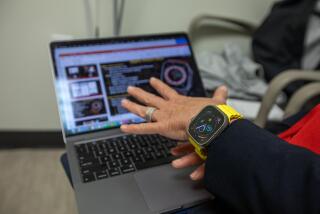The Workplace Is Coming Unplugged
- Share via
There’s a debate raging in the medical community about how to prevent deaths caused by patients being given the wrong medicine by mistake, a situation sometimes attributed to a doctor’s illegible handwriting.
At the San Jose Medical Group, doctors have come up with solution. They--like many others nationwide in a variety of professions and businesses--have gone wireless.
The physicians have thrown out their little white prescription pads and replaced them with the “personal prescriber,” a Hewlett-Packard hand-held PC loaded with pharmaceutical software. It has eliminated confusion about illegible prescriptions and made it easier for doctors to track medical records.
The device automatically tells doctors which medications are covered by a patient’s insurance. Then the physician clicks off a drug choice and a transmitter sends the information to a pharmacy or to the medical group’s own dispensary.
The device also checks to see whether new medications interact properly with others the patient is taking. “An elderly patient may be receiving meds from different doctors. This tracks all their medications,” said Dr. David Trager, the pediatrician who led his group across the wireless frontier.
“Of the 140 doctors we have, about eight were resistant to [the change],” Trager said. “One of them doesn’t even have an ATM card.” The doctors pay $250 a month for the subscription service.
The leap to wireless has affected many businesses. Vending-machine companies now take inventory from a distance, using cell phones to determine how many Mars bars or cans of Coca-Cola have been sold. Oil wells and irrigation systems can be monitored remotely using wireless technology. And freight trucks are tracked by satellite throughout the country.
Consider truck driver Mike Booth.
Within 10 minutes of dropping off a cargo of soup noodles in Strongville, Ohio, Booth got an electronic message from his dispatcher assigning him to pick up a load of cereal boxes 20 minutes away.
The dispatcher at HTL Trucking in Omaha, Neb., knew that Booth was available because he’s in constant communication via a wireless system called OmniTRACS. Developed by Qualcomm, a San Diego communications firm, a small laptop device next to the dashboard offers a two-way electronic messaging system transmitted over satellite.
Booth, who lives in Virginia, drives for HTL all over the country. But as an independent contractor, he doesn’t earn any money when his truck is empty. He said he gets assignments quickly with the new messaging system, rather than playing a waiting game that sometimes lasted for hours or days.
“Before we had . . . to stop and call the dispatcher by phone and wait on hold for 20 minutes,” Booth said. “If you weren’t at a phone, they might give a load to someone else.”
Now dispatchers contact Booth via e-mail, typically offering him two or three choices about where he will head next. The dispatchers can also send out warnings about bad weather, traffic conditions and even fuel prices. The trucking company is also able to track his location so they can provide updates to clients about when their cargo will arrive.
“That’s important because we do a lot of just-in-time deliveries,” Booth said.
The wireless revolution has made Booth’s life easier in other ways. When his truck broke down last year, an HTL mechanic sent him messages instructing him how to fix it. Last year, he also bought a cell phone, which is more convenient than looking for a pay phone. He has also installed a DirecTV satellite dish on his truck so he can enjoy his favorite shows when he takes a break from driving.
Cell phones have unclogged the workday for some people. At Bill Howe Plumbing in San Diego, plumbers keep in touch via a mini-network of 40 cell phones, which have replaced their pagers. If they were paged on the road, they had to stop and use a pay phone. If they were paged on the job, they had to ask a customer to use their phone.
The company’s cell phone bill is about $2,500 a month, said John Padilla, general manager at the company. But that expense has already been made up in extra work.
“We run into a lot of emergency situations. This way the communication is instant,” Padilla said.
In some professions, wireless isn’t all that new. For more than a decade, the Los Angeles County Sheriff’s Department has been using wireless devices so deputies can communicate with dispatchers. But the “dumb” terminals they have been using are being traded in for more user-friendly wireless laptops.
The old terminals could receive information from state databases and from dispatchers, but their storage capacity was limited. The new devices will come with their own hard drives, which hold far more software. This month, deputies will begin using the more durable laptops, specifically designed for police cars where temperatures can get as high as 120 degrees.
“The computer environment in a car is dramatically different from in an office,” said Chief Lee Davenport.
The rest of county government in Los Angeles is also looking to incorporate wireless technology into the workplace, said Jon W. Fullinwider, chief information officer for the county. There are already discussions about giving wireless laptops to case workers in the welfare and children’s services departments. That way, he said, case workers could have access to the county’s computer databases when they visit clients and questions arise about records.
“The question is, can we take county services to the client,” Fullinwider said. “Technology will make that very viable.”
More to Read
Inside the business of entertainment
The Wide Shot brings you news, analysis and insights on everything from streaming wars to production — and what it all means for the future.
You may occasionally receive promotional content from the Los Angeles Times.









